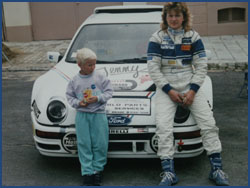Romana with the Renault 5
Romana Zrnec is a Slovenian driver most famous for winning the Croatia Delta Rally outright in 1986. Her car was a Renault 11 and her co-driver was Spela Kozar. This was one of four rallies that she won outright during her career.
Romana was born in 1961. At that time, Slovenia was part of Yugoslavia. Cars were not a huge part of her upbringing. Only her mother drove in her family. The young Romana looked up to her mother, but only discovered motorsport as an adult.
Her first car was a Mini Cooper. She did two rallies in it, finishing one with a class fourth. After that, she was picked up by Renault, who were looking for a female driver to rally one of their cars as a marketing exercise. She proved so effective that they kept her on.
By the age of 22, she was involved in national-level rallying. Throughout her career, she remained quite loyal to the Renault marque. Her car for 1983 was a Renault 5 Alpine. Right from the start, she was competitive. In September, she was fifth overall in the YU Rally, the Yugoslav national rally, and ninth in the Rally Saturnus. Her other international rally was the Barum event in what was then Czechoslovakia. She was 25th.
In 1984, she began a partnership with a new co-driver, Suzanna Bagari, which lasted for two seasons. The duo competed in Austria, scoring one tenth place in the Atrium Sauna Karnten Rally and winning their class. They also tackled the Semperit Rally, and were 32nd overall.
Romana upgraded the Renault 5 to a Renault 11 for 1985. This resulted in her first outright win, on the Rally Velenje. This was part of her home championship. She also tried out some more rallies abroad. The best of these for her was the Albena Rally in Bulgaria. She was 29th overall.
She concentrated most on the 1986 Yugoslav championship; her only big European outing was the Bohemia Rally, in which she was 33rd in the Renault 11. Early in the season, in the spring, she won two more rallies outright: the Rally Riviera Opatija and the Ina Delta Rally. Her Delta win was against Vojko Podobnik in the much more powerful Porsche 911. At the end of May, she was ninth in the Rally Saturnus, one of her favourite events. The season ended with another podium: a third place in the Rally Prijateljstva. Romana was the runner-up in that year’s Yugoslavian rally championship, behind Vojko Podobnik.
She spread her wings again in 1987, driving the Renault for the ARD Kompas team. She improved her Saturnus result to second, behind Polish driver Andrzej Koper in another 11. This was also frustrating, as she had been leading until the final stage when a turbocharger went. In July, she entered her first Rally Poland, and was fifth overall. Three months later, October was a busy month for her. She won another Rally Prijateljstva, then travelled to the Iberian peninsula for the ERC rallies there. Sadly, she did not finish either the Catalunya or the Lois Algarve events.
She had a new car in 1988: a Renault 5 in GT Turbo trim, run by the HB Rally Team. Using this car, she was thirteenth in Poland and eighth in the YU Rally, the Yugoslav national rally.
1989 was split between domestic and European rallies. Romana was fourth in the Yugoslavian championship, with a best finish of second in the Ina Delta Rally. She was also sixth in the YU Rally. In Europe, she was fourteenth in Rally Poland. Her other big European event was the Rally Piancavallo in Italy, which she did not finish.
This was her last season driving a Renault. In 1990, she started the year in a Ford Escort Cosworth prepared by ARD Kompas. In this car, she was 17th in the Rally Riviera Opatija, but did not finish the Saturnus Rally. Mid-season, she drove a four wheel drive Lancia Delta Integrale, in Group N trim, on the Polish Rally. She was fourteenth again, second in class.
The Polish Rally turned out to be her last event. She became pregnant with a son in 1990, and did not return after his birth. An added issue that kept her away was the difficulty in putting together a budget to rally at the level of which she was capable.
Romana now runs a metal manufacturing company and was involved in politics in the 2000s.
(Image from http://www.forum-auto.com)


















